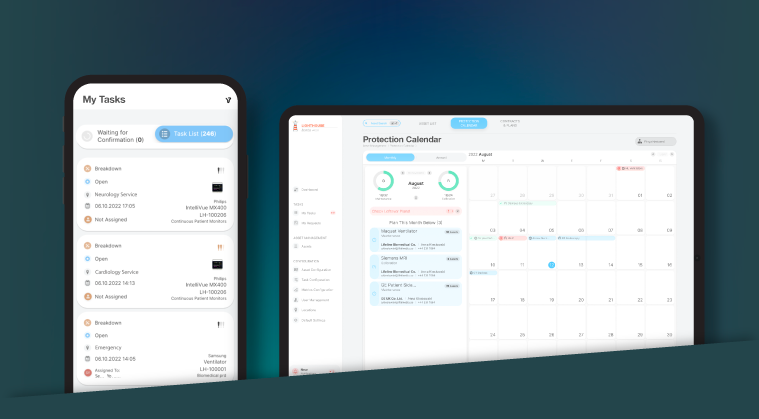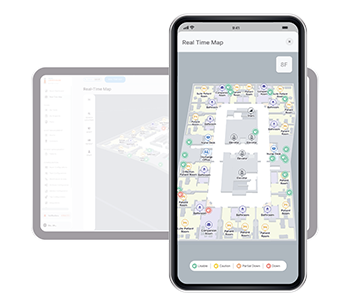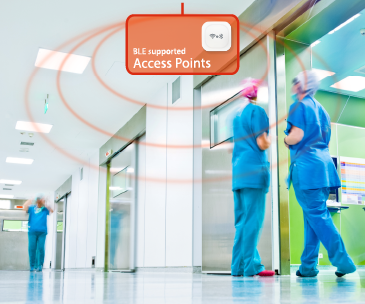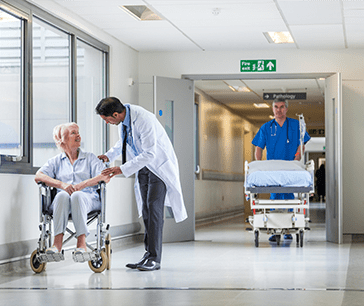
Combining the Power of IoT and RTLS in Healthcare
Combining the Power of IoT and RTLS in Healthcare
The healthcare industry is constantly evolving, and new technologies are being introduced to improve patient care and streamline hospital operations. Two of the most promising technologies in healthcare today, Internet of Things (IoT) and Real-Time Location Systems (RTLS), have emerged as a game-changer for smart hospital operations management. When combined, these technologies offer tremendous potential to improve patient outcomes, reduce costs, and increase efficiency in healthcare.
IoT refers to a network of physical devices, vehicles, home appliances, and other items embedded with electronics, software, sensors, and connectivity which enables these objects to connect and exchange data. The ‘’IoT for Healthcare’’ concept, with its network of interconnected devices and sensors, provides hospitals with a vast web of real-time data.
Real-Time Location System (RTLS) is a system that uses wireless communication to track the real-time location of assets, people, and other objects. In healthcare, RTLS can be used to track patients, assets, and staff, providing real-time information about their location or status.
Complementing the IoT framework, RTLS add an extra layer of sophistication to hospital operations. RTLS utilizes a combination of technologies such as RFID (Radio-Frequency Identification), UWB (Ultra-Wideband) GPS, and Bluetooth to track the real-time location of assets, patients, and staff within the hospital premises.
IoT and RTLS meet in healthcare
When IoT and Real-Time Location Systems meet in healthcare, they create a powerful combination that revolutionizes the way healthcare is delivered. By integrating IoT and RTLS systems in hospitals, the healthcare industry can reap numerous benefits. With real-time data and location tracking, healthcare providers can provide better care to their patients, improve patient outcomes, and create a safer and more efficient healthcare environment.
Providing Better Patient Care
The integration of IoT and RTLS technologies in hospitals revolutionizes patient care through automated tracking and monitoring of patients’ journey throughout the operation theatre process. Patient Flow furnishes actionable data, providing crucial information such as patients’ length of stay pre-op and post-op, transfer times in between, initiation times of surgeries, and more. By pinpointing bottlenecks and identifying the root causes of delays, this advanced system enhances operational awareness, leading to informed interventions that reduce the duration of patients’ stay in the operating room (OR) and enable the treatment of more patients. The implementation of this “IoT for Healthcare” product not only diminishes waiting times but also maximizes the time healthcare providers spend with patients, resulting in an overall improvement in patient satisfaction.
By equipping medical assets with IoT sensors and incorporating RTLS technology, healthcare providers can track the movement and usage of assets, such as wheelchairs and infusion pumps, in real-time. Asset Utilization via RTLS asset tracking capability ensures that these devices are always available when they are needed, reducing the time spend on manual search and extending the time dedicated to delivering critical care to patients.
Enhancing Safety
Safety is one of the most important concerns in any healthcare facility, but this can be difficult given that thousands of patients and hundreds of healthcare staff are present every day. The combination of IoT and RTLS has emerged as a groundbreaking solution, promising to elevate the standards of safety within healthcare facilities by precisely and continuously tracking, patients, staff/personnel and assets.
Patient Wandering product, with RTLS-enabled patient tracking capability, bring forth a robust system that alerts healthcare staff when patients, particularly those at high risk, such as individuals prone to falls or those with Alzheimer’s disease, breach their predefined safe zones. With real-time location data of Patient Tag, attached to patients’ wrists, they can make a Nurse Call at any time of day or night, and healthcare providers can respond more quickly to emergencies. This swift notification system ensures that nurses receive real-time alerts, accompanied by the patient’s precise location data, enabling them to respond promptly and efficiently to the situation at hand.
Infant Safety product integrated with IoT and RTLS presents a cutting-edge approach that provides immediate alerts in the instance of an infant departing from their designated safe area without authorization. The implementation of tamper-proof Infant Tag adds an additional layer of security, offering instant notifications should any attempt be made to tamper with or remove the tag from an infant’s ankle. Moreover, this solution ensures the proper matching of mothers and infants, reducing the risk of confusion or misplacement.
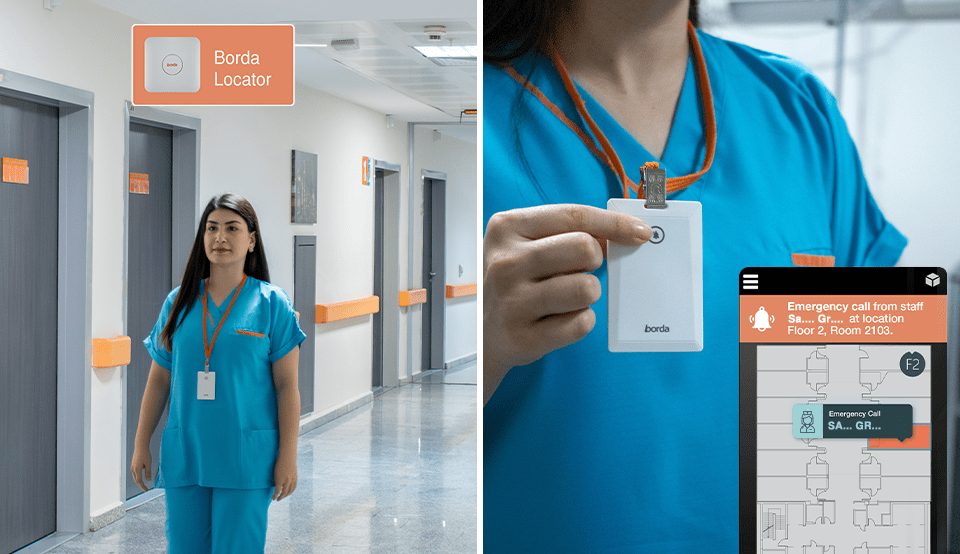
On the other hand, the integration of IoT and RTLS emerges as an indispensable shield, offering unparalleled peace of mind to frontline healthcare workers. Equipped with RTLS-enabled Staff Tags attached to their collars or clipped to their clothing, staff members carry a powerful ally. When the panic button is activated, a swift white code alarm is triggered, transmitting an immediate distress signal to security personnel along with precise real-time location information of the staff in duress. This Staff Duress product not only ensures the constant protection of staff members throughout the facility but also acts as a catalyst in reducing response times dramatically. By accurately pinpointing the exact location of the distress signal, emergency response times become faster than ever.
Efficient Asset Management and Utilization
Managing assets in a healthcare environment has been akin to navigating a complex puzzle. Vital assets, from wheelchairs to life-saving machines, often wander astray, leading to precious time lost in search and retrieval. However, the emergence of IoT and RTLS technologies heralds a new era of asset tracking and management.
RTLS asset tracking isn’t just about knowing where the asset is; it’s about ensuring it’s always where it needs to be, when it’s needed the most. Imagine a scenario where RTLS-enabled tags affixed to medical assets communicate their precise location in real-time. These Asset Tags transmit crucial data, facilitating constant monitoring and allowing hospital staff to instantly locate and retrieve necessary assets. Through the utilization of real-time asset tracking capability, the Asset Utilization product enables hospitals to identify idle assets from heavily utilized ones. It provides insights into actual asset usage rates, facilitating the redistribution of assets to areas where demand is highest. This data-driven approach empowers organizations to make informed decisions regarding purchases, minimizing unnecessary expenses or rentals.
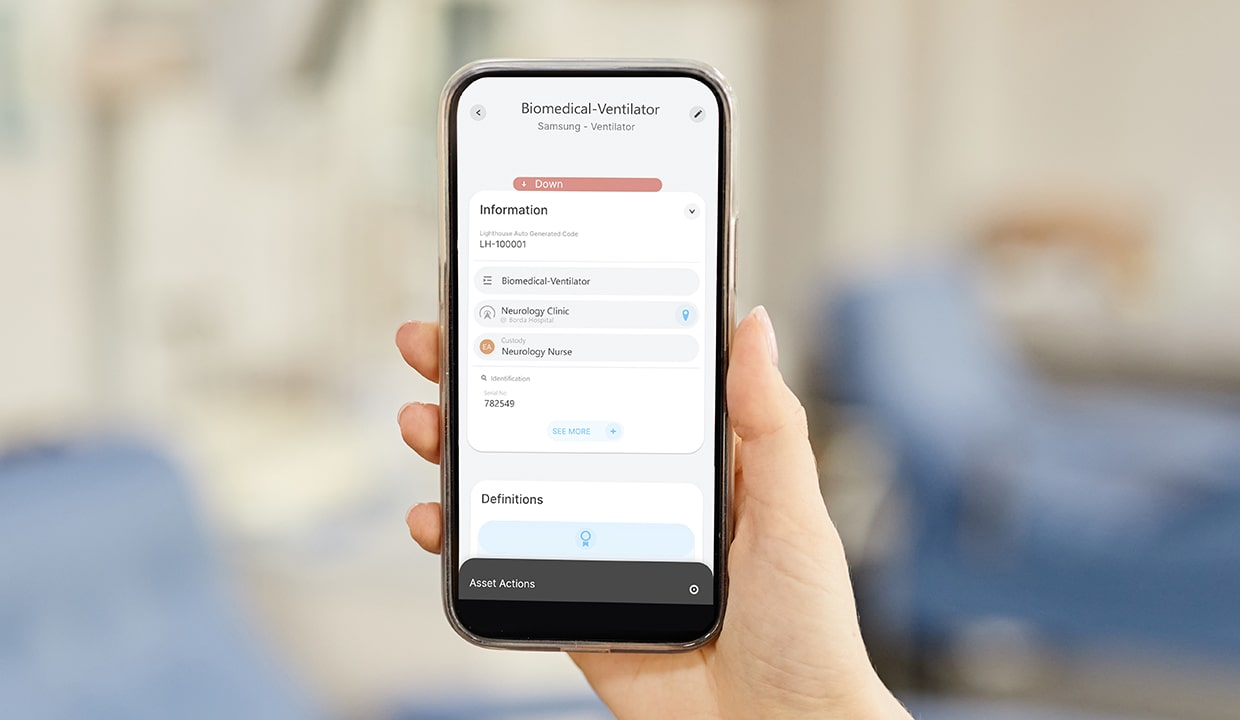
The integration of IoT and RTLS can also optimize hospital asset maintenance/calibration and breakdown management operations. Asset Management (Healthcare CMMS with RTLS capability) product, but much beyond it with RTLS availability and ChatGPT assistant, allows healthcare facilities to manage their maintenance operations, including preventive maintenance and work orders. The AI-assisted Healthcare CMMS software facilitates the seamless submission of maintenance or breakdown requests throughout the entire facility by hospital staff. Each request is promptly assigned to the relevant biomedical technician through a user-friendly mobile application. This Healthcare CMMS also ensures that asset is always available when needed through RTLS tracking capability. Thus, the combination of IoT and RTLS saves staff time, reduces time spent searching for assets, reduces costs, maximizes efficiency, decreases the time it takes to treat patients and ultimately improves operational efficiency.
In conclusion, the combination of IoT and RTLS in healthcare has the potential to revolutionize the way that healthcare is delivered. By providing real-time data, tracking, and information about patients, staff, and assets, these technologies can help to improve patient outcomes, reduce costs, and increase efficiency in the healthcare industry. As technology continues to evolve, it is likely that we will see even more innovative applications of IoT and RTLS technology in the healthcare industry.
Discover our ”IoT for Healthcare” products to transform your hospital operations with IoT and RTLS technology.


